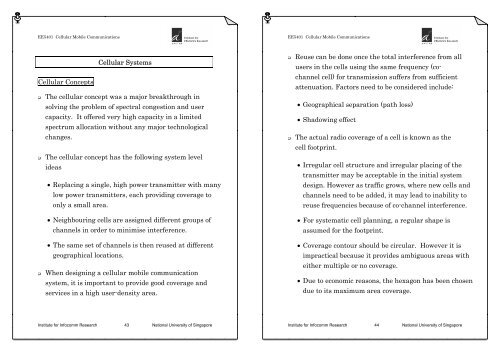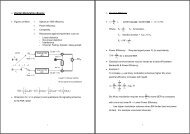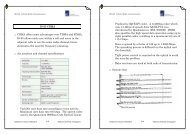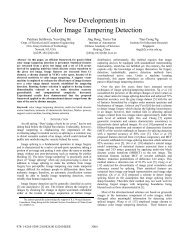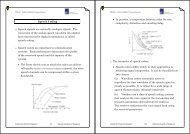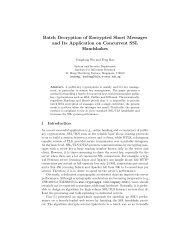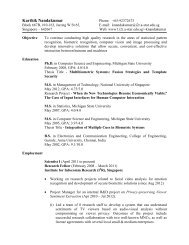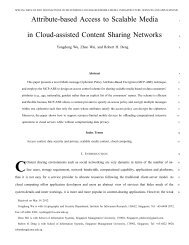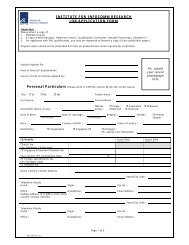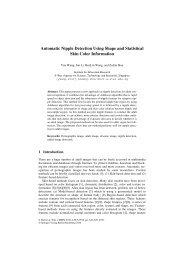Cellular Systems Cellular Concepts The cellular concept was a ...
Cellular Systems Cellular Concepts The cellular concept was a ...
Cellular Systems Cellular Concepts The cellular concept was a ...
You also want an ePaper? Increase the reach of your titles
YUMPU automatically turns print PDFs into web optimized ePapers that Google loves.
EE5401 <strong>Cellular</strong> Mobile Communications<br />
EE5401 <strong>Cellular</strong> Mobile Communications<br />
<strong>Cellular</strong> <strong>Systems</strong><br />
<strong>Cellular</strong> <strong>Concepts</strong><br />
<br />
<br />
<strong>The</strong> <strong>cellular</strong> <strong>concept</strong> <strong>was</strong> a major breakthrough in<br />
solving the problem of spectral congestion and user<br />
capacity. It offered very high capacity in a limited<br />
spectrum allocation without any major technological<br />
changes.<br />
<strong>The</strong> <strong>cellular</strong> <strong>concept</strong> has the following system level<br />
ideas<br />
• Replacing a single, high power transmitter with many<br />
low power transmitters, each providing coverage to<br />
only a small area.<br />
• Neighbouring cells are assigned different groups of<br />
channels in order to minimise interference.<br />
<br />
<br />
Reuse can be done once the total interference from all<br />
users in the cells using the same frequency (cochannel<br />
cell) for transmission suffers from sufficient<br />
attenuation. Factors need to be considered include:<br />
• Geographical separation (path loss)<br />
• Shadowing effect<br />
<strong>The</strong> actual radio coverage of a cell is known as the<br />
cell footprint.<br />
• Irregular cell structure and irregular placing of the<br />
transmitter may be acceptable in the initial system<br />
design. However as traffic grows, where new cells and<br />
channels need to be added, it may lead to inability to<br />
reuse frequencies because of co-channel interference.<br />
• For systematic cell planning, a regular shape is<br />
assumed for the footprint.<br />
<br />
• <strong>The</strong> same set of channels is then reused at different<br />
geographical locations.<br />
When designing a <strong>cellular</strong> mobile communication<br />
system, it is important to provide good coverage and<br />
services in a high user-density area.<br />
• Coverage contour should be circular. However it is<br />
impractical because it provides ambiguous areas with<br />
either multiple or no coverage.<br />
• Due to economic reasons, the hexagon has been chosen<br />
due to its maximum area coverage.<br />
Institute for Infocomm Research 43 National University of Singapore<br />
Institute for Infocomm Research 44 National University of Singapore
EE5401 <strong>Cellular</strong> Mobile Communications<br />
EE5401 <strong>Cellular</strong> Mobile Communications<br />
R<br />
R<br />
R<br />
2<br />
2<br />
2<br />
Atri = 1.3R<br />
Asq<br />
= 2.0R<br />
Ahex<br />
= 2.6R<br />
• Interference tier : A set of co-channel cells at the same<br />
distance from the reference cell is called an<br />
interference tier. <strong>The</strong> set of closest co-channel cells is<br />
call the first tier. <strong>The</strong>re is always 6 co-channel cells in<br />
the first tier.<br />
• Hence, a conventional <strong>cellular</strong> layout is often defined<br />
by a uniform grid of regular hexagons.<br />
Frequency reuse :<br />
• A <strong>cellular</strong> system which has a total of S duplex<br />
channels.<br />
• S channels are divided among N cells, with each cell<br />
uses unique and disjoint channels.<br />
• If each cell is allocated a group of k channels, then<br />
S = kN .<br />
<br />
Co-ordinates for hexagonal <strong>cellular</strong> geometry<br />
• With these co-ordinates, an array of cells can be laid<br />
out so that the center of every cell falls on a point<br />
specified by a pair of integer co-ordinates.<br />
<br />
Terminology<br />
• Cluster size : <strong>The</strong> N cells which collectively use the<br />
complete set of available frequency is called the<br />
cluster size.<br />
• Co-channel cell : <strong>The</strong> set of cells using the same set of<br />
frequencies as the target cell.<br />
If ( ∆ u , ∆v)<br />
= ( i,<br />
j)<br />
, i,j are known as the shift<br />
parameters, then the distance between the two cell<br />
centres is given by<br />
2<br />
2<br />
D = i + j + ij ⋅ 3R<br />
(Cosine’s Rule)<br />
Institute for Infocomm Research 45 National University of Singapore<br />
Institute for Infocomm Research 46 National University of Singapore
EE5401 <strong>Cellular</strong> Mobile Communications<br />
EE5401 <strong>Cellular</strong> Mobile Communications<br />
<br />
Designing a <strong>cellular</strong> system<br />
Examples: N=3,4,7,9,12,13<br />
Proof : to obtain the area of the cluster and compare<br />
with the area of a single cell.<br />
<br />
<strong>The</strong> cluster size must satisfy<br />
2 2<br />
N = i + ij + j where i, j str non-negative integers.<br />
<br />
Can also verify that<br />
D<br />
Q = = 3N<br />
where Q is the co-channel reuse ratio.<br />
R<br />
Institute for Infocomm Research 47 National University of Singapore<br />
Institute for Infocomm Research 48 National University of Singapore
EE5401 <strong>Cellular</strong> Mobile Communications<br />
EE5401 <strong>Cellular</strong> Mobile Communications<br />
Handover / Handoff<br />
<br />
Occurs as a mobile moves into a different cell during<br />
an existing call, or when going from one <strong>cellular</strong><br />
system into another.<br />
• It must be user transparent, successful and not too<br />
frequent.<br />
• If the slope of the short-term average received signal<br />
is steep, handover should carry out fast. Information<br />
about vehicle speed is important.<br />
Handover take place<br />
f1<br />
f2<br />
P HO<br />
• Not only involves identifying a new BS, but also<br />
requires that the voice and control signals be allocated<br />
to channels associated with the new BS.<br />
Time taken to<br />
complete handover<br />
P min<br />
<br />
Once a particular signal level P min is specified as the<br />
minimum usable signal for acceptable voice quality<br />
at the BS receiver, a slightly stronger signal level<br />
P HO is used as a threshold at which a handover is<br />
made.<br />
P HO<br />
= P min<br />
+ ∆<br />
• If ∆ is too large ⇒ unnecessary handovers<br />
• If ∆ is too small ⇒ insufficient time to complete<br />
handovers, call may drop due to poor received signal<br />
quality.<br />
• Running average should be used to avoid unwanted<br />
handover due to momentary fading.<br />
<br />
Dwell Time<br />
• <strong>The</strong> time over which a user remains within one cell is<br />
called the dwell time.<br />
• <strong>The</strong> statistics of the dwell time are important for the<br />
practical design of handover algorithms.<br />
• <strong>The</strong> statistics of the dwell time vary greatly,<br />
depending on the speed of the user and the type of<br />
radio coverage.<br />
Institute for Infocomm Research 49 National University of Singapore<br />
Institute for Infocomm Research 50 National University of Singapore
EE5401 <strong>Cellular</strong> Mobile Communications<br />
EE5401 <strong>Cellular</strong> Mobile Communications<br />
<br />
<br />
Handover indicator<br />
• Each BS constantly monitors the signal strengths of<br />
all of its reverse voice channels to determine the<br />
relative location of each mobile user with respect to<br />
the BS. This information is forwarded to the MSC<br />
who makes decisions regarding handover.<br />
• Mobile assisted handover (MAHO) : <strong>The</strong> mobile<br />
station measures the received power from<br />
surrounding BSs and continually reports the results of<br />
these measurements to the serving BS.<br />
Prioritizing Handover<br />
• Dropped call is considered a more serious event than<br />
call blocking. Channel assignment schemes therefore<br />
must give priority to handover requests.<br />
<br />
which a handover is usually required leaves room for<br />
queueing handover request.<br />
Practical handover<br />
• High speed users and low speed users have vastly<br />
different dwell times which might cause a high<br />
number of handover requests for high speed users.<br />
This will result in interference and traffic<br />
management problem.<br />
• <strong>The</strong> Umbrella Cell approach will help to solve this<br />
problems. High speed users are serviced by large<br />
(macro) cells, while low speed users are handled by<br />
small (micro) cells.<br />
• A fraction of the total available channels in a cell is<br />
reserved only for handover requests. However, this<br />
reduces the total carried traffic. Dynamic allocation<br />
can improve this.<br />
• Queuing of handover requests is another method to<br />
decrease the probability of forced termination of a call<br />
due to a lack of available channel. <strong>The</strong> time span over<br />
Institute for Infocomm Research 51 National University of Singapore<br />
Institute for Infocomm Research 52 National University of Singapore
EE5401 <strong>Cellular</strong> Mobile Communications<br />
EE5401 <strong>Cellular</strong> Mobile Communications<br />
<br />
<br />
A hard handover does “break before make”, ie. <strong>The</strong><br />
old channel connection is broken before the new<br />
allocated channel connection is setup. This obviously<br />
can cause call dropping.<br />
In soft handover, we do “make before break”, ie. <strong>The</strong><br />
new channel connection is established before the old<br />
channel connection is released. This is realized in<br />
CDMA where also BS diversity is used to improve<br />
boundary condition.<br />
A<br />
Hard:<br />
B<br />
Interference and System Capacity<br />
<br />
<br />
In a given coverage area, there are several cells that<br />
use the same set of frequencies. <strong>The</strong>se cells are called<br />
co-channel cells. <strong>The</strong> interference between signals<br />
from these cells is called co-channel interference.<br />
If all cells are approximately of the same size and the<br />
path loss exponent is the same throughout the coverage<br />
area, the transmit power of each BS is almost equal.<br />
We can show that worse case signal to co-channel<br />
interference is independent of the transmitted power.<br />
It becomes a function of the cell radius R, and the<br />
distance to the nearest co-channel cell D’.<br />
A<br />
Soft:<br />
B<br />
(a) Received power at a distance d from the<br />
transmitting antenna is approximated by<br />
−n<br />
⎛ d ⎞<br />
Pr<br />
( d)<br />
= P0<br />
⎜<br />
d<br />
⎟ or<br />
⎝ 0 ⎠<br />
⎛ d ⎞<br />
P r ( d)<br />
( dBm ) = P0 ( dBm ) −10nlog<br />
⎜<br />
⎟<br />
⎝ d0<br />
⎠<br />
(b) Useful signal at the cell boundary is the<br />
weakest, given by P r (R). Interference signal from<br />
the co-channel cell is given to be P r (D′)<br />
.<br />
Institute for Infocomm Research 53 National University of Singapore<br />
Institute for Infocomm Research 54 National University of Singapore
EE5401 <strong>Cellular</strong> Mobile Communications<br />
EE5401 <strong>Cellular</strong> Mobile Communications<br />
(c) D’ is normally approximated by the base station<br />
separation between the two cells D, unless when<br />
accuracy is needed. Hence<br />
−n<br />
R<br />
SIR =<br />
−n<br />
D<br />
• If only first tier co-channel cells are considered, then<br />
i 0 = 6.<br />
• Unless otherwise stated, normally assuming<br />
for all i.<br />
D i ≈ D<br />
<br />
Outage probability : the probability that a mobile<br />
station does not receive a usable signal.<br />
• For GSM, this is 12 dB and for AMPS, this is 18 dB.<br />
If there is 6 co-channel cells, then<br />
n<br />
( D R) ( 3N<br />
)<br />
SIR = =<br />
6<br />
6<br />
Exercise : please verify this<br />
• For n=4, a minimum cluster size of N=7 is needed to<br />
meet the SIR requirements for AMPS.<br />
n<br />
<br />
For the forward link, a very general case,<br />
−n<br />
R<br />
SIR =<br />
i0<br />
−n<br />
∑ Di<br />
i=<br />
1<br />
where D i is the distance of the ith interfering cell<br />
from the mobile, i 0 is the total number of co-channel<br />
cells exist.<br />
• For n=4, a minimum cluster size of N=4 is required to<br />
meet the SIR requirements for GSM<br />
Institute for Infocomm Research 55 National University of Singapore<br />
Institute for Infocomm Research 56 National University of Singapore
EE5401 <strong>Cellular</strong> Mobile Communications<br />
EE5401 <strong>Cellular</strong> Mobile Communications<br />
- More accurate SIR can be obtained by computing<br />
the actual distance.<br />
- Aproximation in distance has been made on the<br />
2 nd tier onwards.<br />
- Our computation of outage only based on path loss.<br />
For more accurate modeling, shadowing and fast<br />
fading need to be taken into consideration. This will<br />
not be covered in this course.<br />
Institute for Infocomm Research 57 National University of Singapore<br />
Institute for Infocomm Research 58 National University of Singapore
EE5401 <strong>Cellular</strong> Mobile Communications<br />
EE5401 <strong>Cellular</strong> Mobile Communications<br />
Coverage Problems<br />
<br />
Revision:<br />
- Recall that the mean measured value,<br />
⎛ d ⎞<br />
PL(<br />
d)<br />
dB = PL(<br />
d0)<br />
dB + 10n<br />
log<br />
⎜<br />
⎟ or<br />
⎝ d0<br />
⎠<br />
P r ( d)<br />
dB = PtdB<br />
− PL(<br />
d)<br />
dB<br />
[ P ( γ ]<br />
β ( γ ) = P r R)<br />
> - cell boundary coverage,<br />
β ( γ )<br />
∞<br />
= ∫<br />
γ<br />
1<br />
2πσ<br />
X dB<br />
⎛ ⎞<br />
⎜γ<br />
− P<br />
= r ( R)<br />
Q ⎟<br />
⎜ ⎟<br />
⎝<br />
σ X dB ⎠<br />
⎡<br />
2⎤<br />
⎢ 1 ⎛<br />
⎞<br />
⎜ X −<br />
− dB Pr<br />
( R)<br />
exp<br />
⎟ ⎥dX<br />
⎢ ⎜<br />
⎟ ⎥ dB<br />
2<br />
⎢⎣<br />
⎝<br />
σ X dB ⎠ ⎥⎦<br />
where Q(x) is the standard normal distribution.<br />
• must know how to use the table.<br />
<br />
- Measurement shows that at any value of d, the<br />
path loss PL (d)<br />
at a particular location is random<br />
and distributed log-normally (normal in dB) about<br />
this mean value.<br />
Pr ( d)<br />
dB = Pr<br />
( d)<br />
dB + X σ<br />
where X σ is a zero-mean Gaussian distributed<br />
random variable (in dB) with standard deviation σ<br />
(in dB).<br />
Boundary coverage<br />
<br />
Cell coverage<br />
• Proportion of locations within the area defined by the<br />
cell radius R, receiving a signal above the threshold γ.<br />
1<br />
U ( γ ) = ∫ P[ Pr<br />
( r)<br />
> γ ] dA<br />
A<br />
A<br />
1<br />
R 2π<br />
⎛ P r ⎞<br />
Q⎜γ<br />
− r ( )<br />
= ∫ ∫<br />
⎟ ⋅ rdr ⋅ dθ<br />
2<br />
πR<br />
⎜<br />
X<br />
⎟<br />
0 0 ⎝<br />
σ<br />
dB ⎠<br />
2<br />
R ⎛ P r ⎞<br />
Q⎜γ<br />
−<br />
=<br />
r ( )<br />
∫<br />
⎟ ⋅ rdr<br />
R ⎜<br />
X<br />
⎟<br />
0 ⎝<br />
σ<br />
dB ⎠<br />
• <strong>The</strong>refore, there will be a proportion of locations at<br />
distance R (cell radius) where a terminal would<br />
experience a received signal above a threshold γ. (γ is<br />
usually the receiver sensitivity)<br />
<strong>The</strong> solution is given in the Rappaport p.107 (1 st<br />
edition).<br />
Institute for Infocomm Research 59 National University of Singapore<br />
Institute for Infocomm Research 60 National University of Singapore
EE5401 <strong>Cellular</strong> Mobile Communications<br />
EE5401 <strong>Cellular</strong> Mobile Communications<br />
Solution can be found using the graph provided. (n :<br />
path loss exponent)<br />
<br />
<strong>The</strong> mean signal level at any distance is determined<br />
by path loss and the variance is determined by the<br />
resulting fading distribution (log-normal shadowing,<br />
Rayleigh fading, Nakagami-m, etc). In this course, we<br />
will deal with log-normal shadowing only.<br />
<br />
<strong>The</strong> proportion of locations covered at a given<br />
distance (cell boundary, for example) from BS can be<br />
found directly from the resultant signal pdf/cdf.<br />
<br />
<strong>The</strong> proportion of locations covered within a circular<br />
region defined by a radius R (the cell area, for<br />
example) can be found by integrating the resultant<br />
cdf over the cell area.<br />
Example: if n=4, σ=8 dB, and if the boundary is to<br />
have 75% coverage (75% of the time the signal is to<br />
exceed the threshold at the boundary), then the<br />
area coverage is equal to 94%.<br />
If n=2, σ=8 dB, and if the boundary is to have 75%<br />
coverage, then the area coverage is equal to 91%.<br />
<br />
An operator needs to meet certain coverage criteria.<br />
This is typically the “90% rule” – 90% of a given<br />
geographical area must be covered for 90% of the<br />
time.<br />
Institute for Infocomm Research 61 National University of Singapore<br />
Institute for Infocomm Research 62 National University of Singapore
EE5401 <strong>Cellular</strong> Mobile Communications<br />
EE5401 <strong>Cellular</strong> Mobile Communications<br />
<strong>Cellular</strong> Traffic<br />
- Call holding time (H) : the average duration of a call.<br />
- Request rate (λ) : average number of call requests per<br />
unit time.<br />
<br />
<strong>The</strong> basic consideration in the design of a <strong>cellular</strong><br />
system is the sizing of the system. Sizing has two<br />
components to be considered.<br />
- Coverage area<br />
- Traffic handling capability<br />
• After the system is sized, channels are assigned to<br />
cells using the assignment schemes mentioned before.<br />
<br />
Traffic flow or intensity A<br />
• Measured in Erlang, which is defined as the callminute<br />
per minute.<br />
• Total offered traffic for such a system is given as<br />
A = λ ⋅ H<br />
Exercise : <strong>The</strong>re are 3000 calls per hour in a cell,<br />
each lasting an average of 1.76 min.<br />
<br />
Terminology in traffic theory<br />
Offered traffic A = (3000/60)(1.76) = 88 Erlangs<br />
- Trunking : exploits the statistical characteristics of<br />
the users calling behaviour. Any efficient<br />
communication system relies on trunking to<br />
accommodate a large number of users with a limited<br />
number of channels.<br />
- Grade of service (GoS) : A user is allocated a channel<br />
on a per call basis. GoS is a measure of the ability of<br />
a user to access a trunked system during the busiest<br />
hour. It is typically given as the likelihood that a call<br />
is blocked (also known as blocking probability<br />
mentioned before).<br />
- Trunking theory : is used to determine the number of<br />
channels required to service a certain offered traffic<br />
at a specific GoS.<br />
<br />
<br />
<br />
If the offered traffic exceeds the maximum possible<br />
carried traffic, blocking occurs. <strong>The</strong>re are three<br />
different strategies to be used.<br />
- Blocked calls cleared<br />
- Blocked calls delayed<br />
Trunking efficiency : is defined as the carried traffic<br />
intensity in Erlangs per channel, which is a value<br />
between zero and one. It is a function of the number<br />
of channels per cell and the specific GoS parameters.<br />
Call arrival process: it is widely accepted that calls<br />
have a Poisson arrival.<br />
Institute for Infocomm Research 63 National University of Singapore<br />
Institute for Infocomm Research 64 National University of Singapore
EE5401 <strong>Cellular</strong> Mobile Communications<br />
EE5401 <strong>Cellular</strong> Mobile Communications<br />
Over an observation period T, divide this time into<br />
n sub-intervals.<br />
- only one arrival can occur in any one sub-interval.<br />
- call arrivals are independent from each other.<br />
- the probability that an arrival occurs in one of<br />
the sub-intervals is proportional to the subinterval<br />
length.<br />
<strong>The</strong> probability of exactly k arrivals in n subintervals<br />
can be evaluated using the binomial<br />
distribution. In the limit when n→∞ , this<br />
approach to a Poisson Process, with its mean equal<br />
to λ T .<br />
(Refer to tutorial 1 and extend the <strong>concept</strong> from<br />
Poisson distribution to Poisson Process)<br />
( λT<br />
)<br />
k<br />
pk<br />
= exp<br />
k!<br />
( − λT<br />
)<br />
- <strong>The</strong> probability that a call terminates within one<br />
subinterval is proportional to its length.<br />
- <strong>The</strong> call termination occurs independently of which<br />
subinterval is considered.<br />
<strong>The</strong> probability that the holding time h is less than<br />
or equal t is given as<br />
n<br />
⎛ µ t ⎞<br />
1 − Fh ( t)<br />
= 1 − P(<br />
h ≤ t)<br />
= P(<br />
h > t)<br />
= lim ⎜1<br />
− ⎟ = exp µ<br />
n→∞⎝<br />
n ⎠<br />
∴Fh ( t)<br />
= 1−<br />
exp( − µ t) ⇒ fh(<br />
t)<br />
= µ exp( − µ t)<br />
This gives a mean holding time of H =1 µ .<br />
( − t)<br />
Markov chain : probability that the next state is x n+ 1<br />
depends only upon the current state x n and not any<br />
previous value. A special case is the birth-death<br />
process.<br />
<br />
Mean inter-arrival time<br />
( τ ≤ t) = 1−<br />
P( τ > t) = 1−<br />
P( no ) = 1−<br />
( − λt)<br />
λ exp( − λt)<br />
Fτ<br />
( t)<br />
= P<br />
arrival exp<br />
∴ fτ<br />
( t)<br />
=<br />
<br />
Block calls cleared : Assuming that there are altogether<br />
C trunks, and<br />
• An infinite subscriber population<br />
<br />
Memoryless property of the negative exponential<br />
distribution : the past history of an exponentially<br />
distributed random variable has no influence in<br />
predicting its future.<br />
• Poisson call arrivals with rate λ calls/sec<br />
• Exponentially distributed call durations with mean<br />
H =1/ µ .<br />
<br />
Call holding time : it is normally assume that it has a<br />
negative exponential distribution.<br />
• Blocked calls are cleared.<br />
Institute for Infocomm Research 65 National University of Singapore<br />
Institute for Infocomm Research 66 National University of Singapore
EE5401 <strong>Cellular</strong> Mobile Communications<br />
EE5401 <strong>Cellular</strong> Mobile Communications<br />
Under steady state conditions<br />
Pn = n ⋅ P n<br />
λδ ⋅ − 1 µδ<br />
Solving for different values of n, we have<br />
n<br />
λ<br />
λ 1 ⎛ λ ⎞<br />
P 1 = P 0 , …, Pn<br />
= Pn<br />
−1<br />
= ⎜ ⎟ P0<br />
, …<br />
µ<br />
nµ<br />
n!<br />
⎝ µ ⎠<br />
C<br />
From ∑ P n = 1, we get<br />
n=<br />
0<br />
1<br />
P0<br />
=<br />
C n<br />
1 ⎛ λ ⎞<br />
∑ ⎜ ⎟<br />
n=<br />
0 n!<br />
⎝ µ ⎠<br />
<strong>The</strong> probability of blocking for C trunked channel is<br />
C<br />
1 ⎛ λ ⎞<br />
⎜ ⎟ 1<br />
C<br />
C<br />
A<br />
1 ⎛ λ ⎞ C!<br />
⎟ =<br />
⎝ µ<br />
GoS = P = ⎜<br />
⎠<br />
c P<br />
= C!<br />
0<br />
C!<br />
C<br />
⎝ µ ⎠ C n<br />
1 ⎛ λ ⎞ 1 n<br />
∑ ⎜ ⎟ ∑ A<br />
n=<br />
n ⎝ ⎠ n=<br />
0 n!<br />
0 ! µ<br />
which is the Erlang B formula, and A = λ H = λ µ .<br />
• Must know how to use the table.<br />
Examples on Erlang B models<br />
<br />
1. <strong>The</strong>re are 3000 calls per hour in a cell, each lasting<br />
an average of 1.76 minutes. For a 2% blocking<br />
probability, how many channels are needed in the<br />
cell?<br />
2. A cell contains 50 channels. <strong>The</strong> average call<br />
duration is 100s. How many calls per hour can be<br />
handle if PB=2%?<br />
Blocked calls delayed : in this model, the blocked<br />
calls are allowed to queue up and wait to be served.<br />
Normally assume that the queue is infinitely long<br />
(M/M/C/∞)<br />
At steady state,<br />
λδ ⋅ Pn − 1 = nµδ<br />
⋅ P n for k ≤ C<br />
λδ ⋅ Pn − 1 = Cµδ<br />
⋅ P n for k ≥ C<br />
This leads to<br />
⎧<br />
n<br />
1 ⎛ λ ⎞<br />
⎪ ⎜ ⎟ P0<br />
n ≤ C<br />
n!<br />
⎝ µ<br />
P = ⎠<br />
n ⎨ n<br />
⎪ 1 ⎛ λ ⎞ 1<br />
≥<br />
⎪<br />
⎜ ⎟ P n C<br />
−<br />
⎩C!<br />
n C 0<br />
⎝ µ ⎠ C<br />
From = 1<br />
n∑ ∞ P n , we get<br />
= 0<br />
Institute for Infocomm Research 67 National University of Singapore<br />
Institute for Infocomm Research 68 National University of Singapore
EE5401 <strong>Cellular</strong> Mobile Communications<br />
EE5401 <strong>Cellular</strong> Mobile Communications<br />
P<br />
0<br />
=<br />
C<br />
∑ − 1<br />
n=<br />
0<br />
1 ⎛ λ ⎞<br />
⎜ ⎟<br />
n!<br />
⎝ µ ⎠<br />
n<br />
1<br />
1 ⎛ λ ⎞<br />
+ ⎜ ⎟<br />
C!<br />
⎝ µ ⎠<br />
C<br />
1<br />
⎛ λ ⎞<br />
⎜1<br />
− ⎟<br />
⎝ µ C ⎠<br />
<strong>The</strong> probability that the call will not have<br />
immediate access to a channel (i.e. having nonzero<br />
delay)<br />
Pr( delay<br />
> 0) = ∑ ∞ P<br />
=<br />
k<br />
k C<br />
C<br />
A 1<br />
= P<br />
C!<br />
A<br />
1−<br />
C<br />
where A = λ / µ . This is the Erlang C formula.<br />
- This probability of non-zero delay that can be<br />
tolerated is also known to be the GoS parameter of<br />
the Erlang C system.<br />
- If no channels are immediately available, the call<br />
is delayed, and the probability that the delayed<br />
call is forced to wait more than t seconds is given<br />
by the probability that a call is delayed, multiplied<br />
by the conditional probability that the delay is<br />
greater than t seconds (the delay threshold).<br />
Pr(delay > t)<br />
= Pr(delay > 0) Pr(delay > t delay > 0)<br />
= Pr(delay > 0) exp[ −(<br />
C − A)<br />
t / H ]<br />
- <strong>The</strong> average delay D for all calls in a queued<br />
system is given by<br />
∞<br />
H<br />
D = ∫ Pr(delay > t)<br />
dt = Pr(delay > 0)<br />
0<br />
C − A<br />
or the average delay for those calls which are<br />
queue is given by H /( C − A)<br />
.<br />
0<br />
Note: Proof for<br />
Pr( delay > t delay > 0) = exp[ −(<br />
C − A)<br />
t / H ]<br />
Consider C=1, this corresponding to the M/M/1 queue<br />
model. <strong>The</strong> waiting time W consists of the service times of<br />
the existing N customers in the system, ie.,<br />
W = S1 + S2<br />
+ L+<br />
S N where S i follows exponential<br />
distribution fS ( t)<br />
= µ exp( − µ t)<br />
and W is the sum of these N<br />
i<br />
independent random variables. Note that implicity we<br />
assume that N > 0 .<br />
λ λ n<br />
Also can easily show that P n = (1 − )( ) , i.e. n follows a<br />
µ µ<br />
geometric distribution (memoryless property).<br />
<strong>The</strong> pdf of W is then given by<br />
Erlang(<br />
n+<br />
1, µ )<br />
64748 4<br />
∞<br />
∞ n<br />
( µ t)<br />
−µ<br />
t λ λ n<br />
fW<br />
( t)<br />
= ∑ f<br />
W | n<br />
( t,<br />
n)<br />
Pn<br />
= ∑ µ e ⋅ (1 − )( )<br />
n=<br />
0<br />
n=<br />
0 n!<br />
µ µ<br />
−(<br />
µ −λ)<br />
t<br />
= ( µ − λ)<br />
e<br />
Note that µ = 1/ H , A = λH<br />
, integrate this from t to ∞ will<br />
obtain Pr( delay > t delay > 0)<br />
For M/M/C queue, the system behaves as an M/M/1 queue<br />
with higher service rate C µ (rather than µ ).<br />
Institute for Infocomm Research 69 National University of Singapore<br />
Institute for Infocomm Research 70 National University of Singapore
EE5401 <strong>Cellular</strong> Mobile Communications<br />
EE5401 <strong>Cellular</strong> Mobile Communications<br />
Channel Assignment Strategies<br />
<br />
Channel allocation schemes can affect the performance<br />
of the system.<br />
Fixed Channel Allocation (FCA) :<br />
• Channels are divided in sets.<br />
• A set of channels is permanently allocated to each cell<br />
in the network. Same set of channels must be<br />
assigned to cells separated by a certain distance to<br />
reduce co-channel interference.<br />
• Any call attempt within the cell can only be served by<br />
the unused channels in that particular cell. <strong>The</strong><br />
service is blocked if all channels have used up.<br />
• Most easiest to implement but least flexibility.<br />
• An modification to this is ‘borrowing scheme’. Cell<br />
(acceptor cell) that has used all its nominal channels<br />
can borrow free channels from its neighboring cell<br />
(donor cell) to accommodate new calls.<br />
• Borrowing can be done in a few ways: borrowing from<br />
the adjacent cell which has largest number of free<br />
channels, select the first free channel found, etc.<br />
Institute for Infocomm Research 71 National University of Singapore<br />
• To be available for borrowing, the channel must not<br />
interfere with existing calls. <strong>The</strong> borrowed channel<br />
should be returned once the channel becomes free.<br />
Dynamic Channel Allocaton (DCA) :<br />
• Voice channels are not allocated to any cell<br />
permanently. All channels are kept in a central pool<br />
and are assigned dynamically to new calls as they<br />
arrive in the system.<br />
• Each time a call request is made, the serving BS<br />
requests a channel from the MSC. It then allocates a<br />
channel to the requested cell following an algorithm<br />
that takes into acount the likelihood of future blocking<br />
within the cell, the reuse distance of the channel and<br />
other cost functions ⇒ increase in complexity<br />
• Centralized DCA scheme involves a single controller<br />
selecting a channel for each cell. Distributed DCA<br />
scheme involves a number of controllers scattered<br />
across the network.<br />
• For a new call, a free channel from central pool is<br />
selected based on either the co-channel distance,<br />
signal strength or signal to noise interference ratio.<br />
Flexible channel assignment<br />
Institute for Infocomm Research 72 National University of Singapore
EE5401 <strong>Cellular</strong> Mobile Communications<br />
EE5401 <strong>Cellular</strong> Mobile Communications<br />
<br />
• Divide the total number of channels into two groups,<br />
one of which is used for fixed allocation to the cells,<br />
while the other is kept as a central poor to be shared<br />
by all users.<br />
• Mix the advantages the FCA and DCA, available<br />
schemes are scheduled and predictive.<br />
Channels need to be assigned to users to accommodate<br />
- new calls<br />
- handovers<br />
With the objective of increasing capacity and<br />
minimizing probability of a blocked call.<br />
<br />
System Expansion Techniques<br />
As demand for wireless services increases, the number<br />
of channels assigned to a cell eventually becomes<br />
insufficient to support the required number of users.<br />
More channels must therefore be made available per<br />
unit area.<br />
• This can be accomplished by dividing each initial cell<br />
area into a number of smaller cells, a technique<br />
known as cell-splitting.<br />
• It can also be accomplished by having more channels<br />
per cell, i.e. by having a smaller reuse factor.<br />
However, to have a smaller reuse factor, the cochannel<br />
interference must be reduced. This can be<br />
done by using antenna sectorization.<br />
<br />
Cell splitting<br />
• Cell splitting increases the number of BSs in order to<br />
increase capacity. <strong>The</strong>re will be a corresponding<br />
reduction in antenna height and transmitter power.<br />
• Cell splitting accommodates a modular growth<br />
capability. This in turn leads to capacity increase<br />
Institute for Infocomm Research 73 National University of Singapore<br />
Institute for Infocomm Research 74 National University of Singapore
EE5401 <strong>Cellular</strong> Mobile Communications<br />
EE5401 <strong>Cellular</strong> Mobile Communications<br />
essentially via a system re-scaling of the <strong>cellular</strong><br />
geometry without any changes in frequency planning.<br />
• Small cells lead to more cells/area which in turn leads<br />
to increased traffic capacity.<br />
• For new cells to be smaller in size, the transmit power<br />
must be reduced. If n=4, then with a reduction of cell<br />
radius by a factor of 2, the transmit power should be<br />
reduced by a factor of 2 4 (why?)<br />
• In theory, cell splitting could be repeated indefinitely.<br />
In practice it is limited<br />
1. by the cost of base stations<br />
2. handover (fast and low speed traffic)<br />
3. not all cells are split at the same time : practical<br />
problems of BS sites, such as co-channel<br />
interference exist<br />
<br />
4. Innovative channel assignment schemes must<br />
be developed to address this problem for<br />
practical systems.<br />
Sectorization<br />
• Keep the cell radius but decrease the D/R ratio. In<br />
order to do this, we must reduce the relative<br />
interference without increasing the transmit power.<br />
• Sectorization relies on antenna placement and<br />
directivity to reduce co-channel interference. Beams<br />
are kept within either a 60° or a 120° sector.<br />
Institute for Infocomm Research 75 National University of Singapore<br />
Institute for Infocomm Research 76 National University of Singapore
EE5401 <strong>Cellular</strong> Mobile Communications<br />
EE5401 <strong>Cellular</strong> Mobile Communications<br />
• If we partition a cell into three 120° sectors, the<br />
number of co-channel cells are reduced from 6 to 2 in<br />
the first tier.<br />
• Using six sectors of 60°, we have only one co-channel<br />
cell in the first tier.<br />
• Each sector is limited to only using 1/3 or 1/6 of the<br />
available channels. We therefore have a decrease in<br />
trunking efficiency and an increase in the number of<br />
required antennas.<br />
• But how can the increase in system capacity be<br />
achieved?<br />
Institute for Infocomm Research 77 National University of Singapore<br />
Institute for Infocomm Research 78 National University of Singapore
EE5401 <strong>Cellular</strong> Mobile Communications<br />
EE5401 <strong>Cellular</strong> Mobile Communications<br />
<br />
Micro cells<br />
• Micro cells can be introduced to alleviate capacity<br />
problems caused by “hotspots”.<br />
• By clever channel assignment, the reuse factor is<br />
unchanged. As for cell splitting, there will occur<br />
interference problems when macro and micro cells<br />
must co-exist.<br />
Institute for Infocomm Research 79 National University of Singapore<br />
Institute for Infocomm Research 80 National University of Singapore


